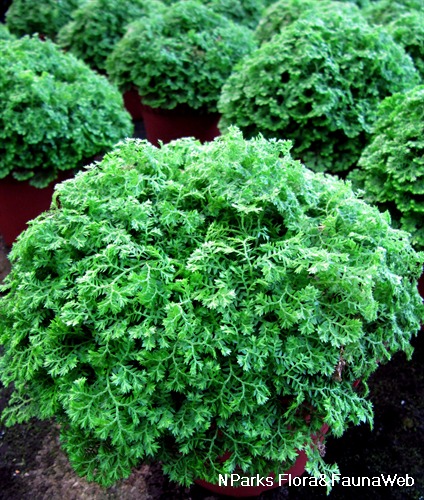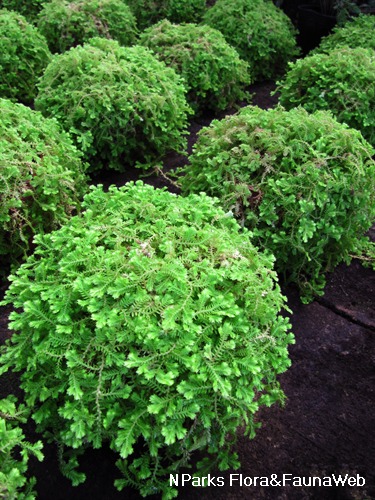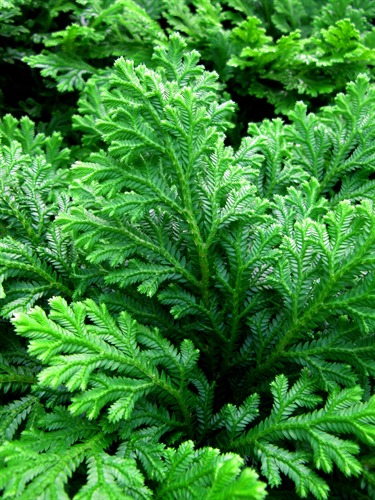.jpg)
Back
Selaginella uncinata (Desv.) Spring
| Family Name: | Selaginellaceae |
| Synonyms: | Lycopodium uncinatum Desv., Lycopodioides uncinata (Desv.) Kuntze |
| Common Name: | Peacock Moss, Blue Spike Moss, Rainbow Moss, 翠云草 |
Selaginella uncinata or Peacock Moss is a scrawling herb that can grow more than 100 cm long. Leaves are papery, green to metallic blue-green coloured. It produces two sets of foliage, the leaves along the sides of the main stem are larger than the paired, overlapping leaves on the main stem. The strobilus is produced singly at the tip of the branch.
Name
Classifications and Characteristics
| Plant Division | Ferns & Lycophytes (Non-Seed Vascular Plants) |
|---|---|
| Plant Growth Form | Herbaceous Plant |
| Mode of Nutrition | Autotrophic |
Biogeography
| Native Distribution | Central & South China to Vietnam |
|---|---|
| Native Habitat | Terrestrial (Mountain, Primary Rainforest, Riverine) |
| Preferred Climate Zone | Sub-Tropical / Monsoonal, Tropical, Temperate |
| Local Conservation Status | Non-native (Horticultural / Cultivated Only) |
Description and Ethnobotany
| Growth Form | It is a scrawling herb that grows between 50 - 100 cm or more. It can also be found hanging, climbing or as an epiphyte on rocky walls. |
|---|---|
| Foliage | Leaves are papery, white-margined, green to metallic blue-green coloured. It has two sets of foliage, the larger leaves along the sides of the main stem and smaller pairs of leaves on the main stem. The larger leaves are broadly elliptic to round, 3 - 4 mm long and 2 - 3 mm wide. The smaller leaves are asymmetrical, oval-shaped, overlapping one another. |
| Reproductive Parts - non-flowering plant | The spore-bearing structure known as a strobilus is compact, ovate-triangular shaped, produced singly at the tip of the branch, measuring 5 - 25 mm long by 2.5 - 4 mm wide. |
| Habitat | Occurs in primary or old secondary forest, hill slopes, river margins or swamps. |
| Cultivation | It thrives in shaded and moist conditions, tend to be intolerable to intense light and drought. To maintain the color of the foliage, a bright location away from direct light is preferred. |
Landscaping Features
| Desirable Plant Features | Ornamental Foliage |
|---|
Plant Care and Propagation
| Light Preference | Full Shade, Semi-Shade |
|---|---|
| Water Preference | Moderate Water, Occasional Misting |
| Plant Growth Rate | Moderate |
| Rootzone Tolerance | Fertile Loamy Soils, Moist Soils, Well-Drained Soils |
| Propagation Method | Division, Spore |
Foliar
| Foliage Retention | Evergreen |
|---|---|
| Mature Foliage Colour(s) | Green, Green - Bluish Green |
| Mature Foliage Texture(s) | Papery |
| Prominent Young Flush Colour(s) | Green - Bluish Green |
| Foliar Type | Simple / Unifoliate |
| Foliar Attachment to Stem | Sessile |
| Foliar Shape(s) | Non-Palm Foliage (Elliptical, Orbicular / Round, Ovate) |
| Foliar Venation | Parallel |
| Foliar Margin | Entire |
| Foliar Apex - Tip | Acuminate, Acute, Mucronate |
| Foliar Base | Cordate, Rounded / Obtuse |
Non - Foliar and Storage
| Stem Type & Modification | Herbaceous |
|---|---|
| Root Type | Underground (Fibrous Root) |
| Specialised Storage Organ(s) | Underground (Rhizome) |
References
| References | Setyawan, A.D. (2014). Short Communication: A new record of naturalised Selaginella uncinata (Desv.) Spring (Selaginellaceae) from Java, Indonesia. Biodiversitas, 15(2): 261-268. Zhang, X., Nooteboom, H.P. & Kato, M. (2013). Selaginellaceae. In: Wu, Z.Y., Raven, P.H., & Hong, D.Y. (eds) Flora of China, vol. 2-3, pp. 37 - 66. Beijing: Science Press; St. Louis: Missouri Botanical Garden Press. |
|---|
Image Repository
Others
| Master ID | 34269 |
|---|---|
| Species ID | 8682 |
| Flora Disclaimer | The information in this website has been compiled from reliable sources, such as reference works on medicinal plants. It is not a substitute for medical advice or treatment and NParks does not purport to provide any medical advice. Readers should always consult his/her physician before using or consuming a plant for medicinal purposes. |

.jpg)
.jpg)
.jpg)



